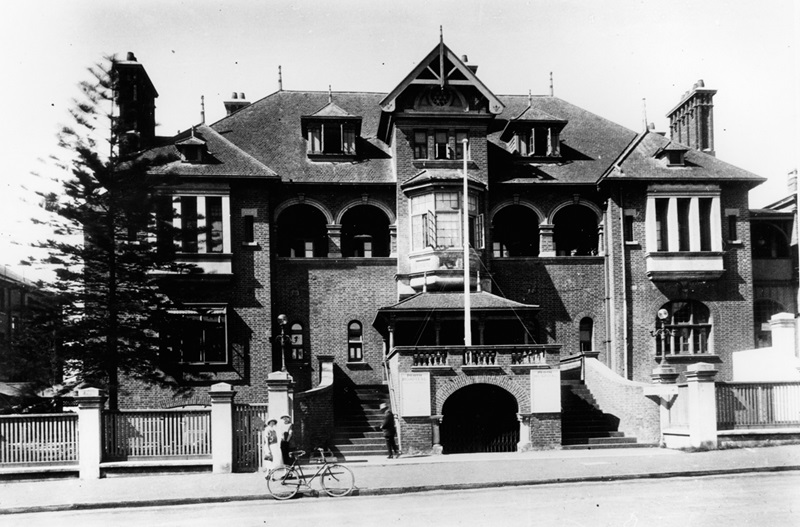History
 We are Western Australia’s longest-serving hospital.
We are Western Australia’s longest-serving hospital.
Our origins date back to the old Colonial Hospital which was established on Garden Island in 1829. However, Royal Perth Hospital was not officially opened until July 1855 with about 30 beds.
In the 1840s, a lack of services for the ill led to the planning of a dedicated hospital building, but they never eventuated. Planning recommenced in the 1850s with a ward for males and females complete with a basement for the kitchen, scullery, store, cells for mental health patients and nurses’ quarters.
The Colony was experiencing a shortage of manpower and materials and there were frequent delays in the construction process. Tenders were called for bricks in 1852 and for plastering in 1853. The most serious setback was in 1854 when the foundations gave way and the building had to be redesigned.
The original Hospital building still exists on the corner of Murray Street and Victoria Square - though additions and extensions now hide its Murray Street facade. It is heritage listed and houses the medical library, offices and the old cafeteria function space.
In 1939 plans were drawn for a new major multi-storey building and the old A Block was demolished to make room for a new A Block (now known as South Block), which still houses most of the wards at the hospital. Work on South Block was abandoned during the war and it was finally opened in 1949.
The creation of the North Block building was also beset by delays - the Tonkin State Government approved the development in 1972 but in 1979 the Commonwealth Government discontinued funding for the project and construction was abandoned, leaving a skeleton of concrete floors and supporting columns. It was finally completed and opened in 1988.
The Royal Perth Hospital art collection is the largest hospital collection in Australia. More than 1000 paintings, drawings and wall-based sculptural works are on display throughout the hospital.
Royal Perth Hospital Art Committee member Dr Barry Walters said sensory stimulation was important for patients, and that art could play a positive role in healing.
Dr Walters said the artworks around the walls of our hospital provide patients and visitors with an opportunity to enjoy something of their surroundings – a pause in their hospital experience.
Among the most recognised pieces that make up the collection are works by:
- Rupert Bunny
- Sir Arthur Streeton
- Norman Lindsay
- Arthur Boyd
- Kathleen O'Connor
- Albert Namatjira
- Charles Blackman
- Jeffrey Smart
- Howard Taylor
- Robert Juniper
- Guy Grey-Smith
- Rover Thomas
- Theo Koning
- Ronnie Tjampatjimpa
- Julie Dowling
- Max Pam
Believing that the public should have the opportunity to engage with art outside of galleries and in their everyday lives, art collector Sir Claude Hotchin OBE established the collection in 1954.
By 1977, Sir Claude's belief in art as an important means of public communication saw the collection grow to over 500 works.
The Sir Claude Hotchin Art Collection has continued to grow over the years, thanks to numerous supporters, collectors, patients and artists who have continued to donate work.
The collection is an important public resource and the diversity of the works ensures that a variety of interests, opinions and tastes are represented.
For more information on donating artwork to the art collection and the Cultural Gifts Program, please contact the Art Curator on (08) 9224 2244.
The Royal Perth Hospital (RPH) Emeritus Consultant biographies have been prepared by Gwynne Brockis, Richard Davis and Neil Cumpston. The biographies provide an overview of the life and career of RPH's Emeritus Consultants.
Download the Emeritus Consultant biographies:
Visit Royal Perth Hospital Museum and explore the history of Western Australia’s longest serving hospital.
Hidden in the RPH Heritage Precinct in Murray Street, just minutes from the centre of Perth, the Museum can be found in the 1894 Administration Building alongside the original 1855 Colonial Hospital.
Visit the Museum page for more information.
Professor Barry J. Marshall AC and Dr J. Robin Warren AC were named as the 2005 Nobel Laureates in Physiology or Medicine for their groundbreaking research at Royal Perth Hospital between 1979 and 1984.
Professor Marshall and Dr Warren discovered that infection by a previously unidentified spiral bacterium, Helicobacter pylori, caused gastritis-associated dyspepsia and ulcers, which also increased the risk of stomach cancer.
The discovery of the organisms in the stomach lining of patients by Dr Warren was followed by a remarkable experiment by the young medical registrar Barry Marshall, in which he infected himself, treated the infection with antibiotics and recovered.
Working with the departments of Microbiology, Gastroenterology and Anatomical Pathology, the team developed tests to identify the infection in biopsy samples, blood and breath tests. They also developed very effective treatment strategies using antibiotics. Their landmark discovery revolutionised the diagnosis and treatment of peptic ulcer disease and led to a reduction in the prevalence of gastric cancer.
Dr Warren is a highly regarded pathologist with an interest in gastritis who worked in the Department of Pathology at our hospital for many years. Now retired, Dr Warren is an emeritus consultant. Professor Marshall continues his work at the NHMRC Helicobacter pylori Research Laboratory at Sir Charles Gairdner Hospital, and runs a molecular biology laboratory at the University of Western Australia.
For more information, visit the Nobel Prize website (external site).

